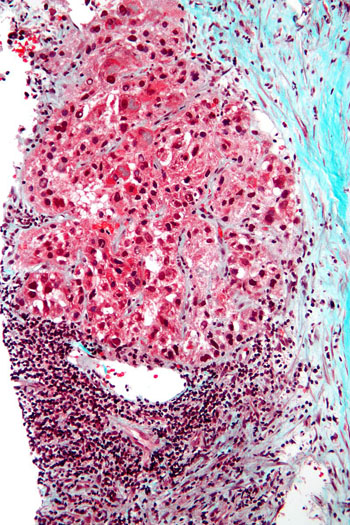Prospective Study of Liver Cancer Risk Shows Value of Circulating microRNAs
By LabMedica International staff writers
Posted on 16 Jun 2016
A prospective study conducted on a group of individuals who had been infected with hepatitis B virus (HBV) has shown that a panel of 15 microRNAs (miRNAs) could predict high or low risk of developing liver cancer (hepatocellular carcinoma).Posted on 16 Jun 2016
The predictive value of circulating miRNAs in HBV-related hepatocellular carcinoma (HCC) has been demonstrated in retrospective studies, but it has rarely been tested in prospective studies. To help correct this deficiency, investigators at Thomas Jefferson University (Philadelphia, PA, USA) measured the expression of 24 retrospectively identified HCC-related miRNAs in baseline serum samples collected from a cohort of 373 cancer-free HBV patients. The patients were monitored for 4.5 years.

Image: A micrograph of hepatocellular carcinoma from a liver biopsy (Photo courtesy of Wikimedia Commons).
Results published in the May 24, 2016, online edition of the journal Oncotarget revealed that during the follow-up period 40 of the patients developed liver cancer.
When the investigators analyzed the prospective associations of miRNA expression with HCC risk using the Cox proportional hazards model, they found that 15 of the 24 miRNAs – miRNAs that targeted genes mainly enriched in the transforming growth factor-beta signaling pathway – exhibited a significant association with HCC risk. In particular, seven miRNAs (miR-122, miR-99a, miR-331, miR-125b, miR-23b, miR-92a, and miR-26a) were associated with an increased risk, and eight miRNAs (miR-652, miR-23a, miR-27a, miR-34a, miR-145, miR-10a, miR-150, and let-7f) were associated with a decreased risk. Knowledge of the risk score significantly increased the HCC prediction performance of the frequently used alpha-fetoprotein analysis method.
"We need to find more microRNAs that may predict liver cancer in order to sharpen this tool for identifying high risk patients," said senior author Dr. Hushan Yang, associate professor of medical oncology at Thomas Jefferson University. "Through collaboration with Dr. Hie-Won Hann in the department of medicine at Thomas Jefferson University, we continue to work on improving this diagnostic method."
Related Links:
Thomas Jefferson University




 assay.jpg)









